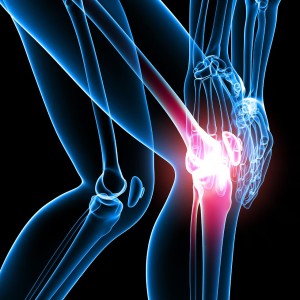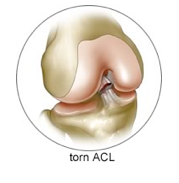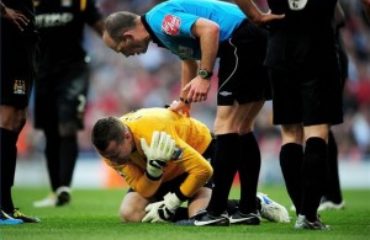The anterior cruciate ligament (ACL) is located in the knee and connects the femur in the thigh to the tibia in the lower leg. If you tear it, most likely you will know it. You will likely hear it, too–patients often hear a loud “pop” when the ligament snaps, and sometimes even people nearby will hear it as well.  The ACL does contain blood vessels, so when injured, your knee will likely internally swell with blood. You will likely not be able to put any weight on your leg or to continue the activity you were doing.
The ACL does contain blood vessels, so when injured, your knee will likely internally swell with blood. You will likely not be able to put any weight on your leg or to continue the activity you were doing.
The ACL functions to stabilize the knee when you turn or plant your feet, and is caused by twisting of the femur and tibia bones in relation to each other. Therefore, it makes sense that most ACL injuries occur during sports that involve planting, cutting, or pivoting movements, regardless of whether it involves contact with another athlete.
An ACL injury is one of the most common knee injuries. Sometimes, the ACL tear is part of a knee injury known as Terrible Triad, involving three ligaments—the ACL, MCL, and medial meniscus—that all simultaneously tear. This injury, also known as O’Donoghue’s Triad, happens in about 10 percent of ACL injuries when the force is applied to the opposite side of the knee, causing both the lateral and posterolateral ligaments to tear.
While an ACL tear is a serious injury, it does not constitute a medical emergency. If the skin is not damaged and pain and swelling are not too severe, there is a relatively easy regimen for early injury management. For the first few days, you can use the RICE regimen–rest, ice, compression, and elevation. If the pain and swelling continue to be severe, then it is likely that the knee cavity is retaining blood, a condition called haemarthrosis.
 It is difficult for an Arizona orthopedic doctor to determine the full extent of your injury while the knee is swollen and painful. After a week or so, when the swelling and pain have mostly subsided, a Phoenix orthopedic surgeon can fully examine and evaluate the knee.
It is difficult for an Arizona orthopedic doctor to determine the full extent of your injury while the knee is swollen and painful. After a week or so, when the swelling and pain have mostly subsided, a Phoenix orthopedic surgeon can fully examine and evaluate the knee.
Most serious athletes that have a complete tear will require an ACL reconstruction to return to sports. There are many choices for reconstruction, and the decision should be thoroughly discussed between the patient and the surgeon.
With Terrible Triad, the MCL tear is rarely at the lower end, and the ligament is usually left to heal on its own. Many MCL, PCL, and meniscal tears will heal on their own with leg stabilization and no surgery, therefore reducing a three-ligament injury down to a single ACL surgical repair.
ACL surgery with a Phoenix sports medicine surgeon typically has a prolonged recovery time, but advances in ACL rehabilitation and post-operative exercise have greatly reduced recovery time. Patients are now safely returning to their activities much more quickly.
Dr. Adam Farber at Phoenix Shoulder and Knee is an expert ACL surgeon in Arizona, call us today to receive top treatment!



